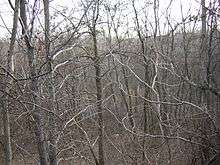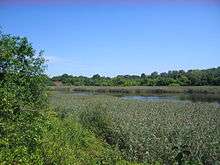Ridgewood Reservoir
Ridgewood Reservoir is a decommissioned 19th century reservoir that sits on the Brooklyn–Queens border in New York City, within what is now Highland Park. The reservoir itself is actually on the Queens side of the border in the neighborhood of Glendale. The reservoir and park are bounded on the north by the Jackie Robinson Parkway, on the south by Highland Boulevard, on the west by the backyards of homes on Bulwer Place and on the east by Cypress Hills National Cemetery.


In 2018 it was listed on the National Register of Historic Places.[1]
Construction
Ridgewood Reservoir was built by the City of Brooklyn, New York, which was rapidly outgrowing its local water supplies. In 1851 the City thought it was failing to attract business firms that would have moved to Brooklyn if it had as reliable a water source as New York City's Croton Aqueduct.[2] Various sources were proposed. The Croton River was thought to be inadequate to New York City's future alone, so would not be available to Brooklyn. The Bronx River was both inadequate and difficult of access. Wells in and near Brooklyn were inadequate both in quantity and quality. Natural lakes on Long Island were few and could not provide enough water. The only solution was to tap the many small streams on Long Island and conduct their water to Brooklyn to be lifted into an elevated reservoir.
The original design of the Ridgewood Reservoir as well as the final specifications for the Brooklyn Water Works system was designed by Brooklyn civil engineer, Samuel McElroy. This original design called for three basins, however, later engineer James P. Kirkwood altered the designs and instead built a double basin.[3] The new double reservoir was built in Snediker's Cornfield on a hilltop near Evergreen Cemetery in what was once part of Ridgewood, Queens (this section of Queens is now part of Glendale) and was sealed by puddling with clay and paving with stones. Ground was broken for the reservoir on July 11, 1856 and water was first raised on November 18, 1858.
.jpg)
In 1862, the water supply for the reservoir consisted of six dammed streams in what is now Queens and Nassau Counties: Jamaica Stream (Baisley Pond), Simonson's Stream, Clear Stream, Valley Stream, Pine's Stream, and Hempstead Stream (Hempstead Lake).[4] This water was carried in a 12-mile-long masonry conduit, called the Ridgewood Aqueduct,[5] to a pumping station at Atlantic Avenue and Chestnut Street near the City Line. There, steam-powered pumps, each with a capacity of 14 million gallons (53,000 m3) per day, forced the water up through a reinforced tube into the high reservoir whence it was distributed. By 1868 the Ridgewood Reservoir held an average of 154.4 million gallons (584,000 m3) daily, enough to supply the City of Brooklyn for ten days at that time.[6]
In subsequent decades the Brooklyn Water Works system was repeatedly expanded by adding wells and collection reservoirs, extending the conduit farther east, and adding pumps. The Ridgewood Reservoir's third basin was completed in 1891.[7] Farmers in southern Queens County complained that Brooklyn's thirst was lowering the water table. Late in the century, the conduit was extended to a large pumping station in Massapequa, some 30 miles (48 km) away. Efforts to extend it farther were thwarted by legislation protecting the water of Suffolk County. Force Tube Avenue, Conduit Boulevard, and Sunrise Highway were built, in part, atop the water conduit or within its right of way, early in the 20th century.
Highland Park was created on land immediately surrounding Ridgewood Reservoir that was purchased by the City of Brooklyn in 1891 under the jurisdiction of the Highland Park Society. The park was constructed between 1901 and 1906 and included additional parcels purchased to the south and west.[8]
Decommissioning
In 1898, Brooklyn merged with the City of Greater New York, thus gaining access to the superior New York City water supply system. Ridgewood Reservoir was expensive to operate because of the need for pumping and was slowly made obsolete by expansion of New York City's Catskill and Delaware water systems. Ridgewood Reservoir became a backup reservoir in 1959 with the third basin being filled with water from the Catskill system. The reservoir was last used in a drought in the 1960s. During the 1970s the reservoir was the site of illegal swimming and a number of drownings. The reservoir was finally decommissioned and drained in 1989.
Some of the Nassau County pumping stations including the one at Milburn (now Baldwin) survived into the 21st century as ruins. Valley Stream State Park, Hempstead Lake State Park, and other South Shore lakes and parks were originally Brooklyn Water Works reservoirs.
Following decommissioning and abandonment, the reservoir naturally became a small birch forest (one of the few on Long Island) with a grassy marsh in the center basin. The creation of this virtual nature sanctuary attracted a wide variety of fauna, including some rare species of birds. The bicycling trail around the reservoir perimeter became part of the 40-mile (64 km) Brooklyn-Queens Greenway.
In 2004, the reservoir was officially turned over to the Department of Parks for more extensive integration into Highland Park.[6] In October 2007, the Parks Commissioner Adrian Benepe quietly unveiled a contract to breach one of the reservoir basins and clear 20 acres (81,000 m2) for new ball fields.[9] However, on June 26, 2008, Comptroller of New York City Bill Thompson, Jr. rejected that contract for the new development, citing concerns about the environmental impact, increased truck traffic, and the vendor selection process.[10] There is an extensive community effort to keep the reservoir in its "natural" state as a nature preserve.
Controversy
In 2014, plans, which were obtained through a freedom of information request by Save Ridgewood Reservoir, a local nonprofit dedicated to keeping the reservoir in its natural state, indicate the City's intention to construct culverts to breach the three basins. These plans illustrate the design and construction of culverts large enough to accommodate trucks and are part of a City Parks Department project that has been said is necessary to eliminate a flooding hazard.[11] This has brought the concerns of development of the site back to the forefront. The City has stated that unless this work is done, the State of New York will issue fines since the reservoir has been classified as a dam and according to guidelines is therefore a flooding hazard. This is not without controversy as local activists have pointed out that only one of the three basins has water in it at any given time and that the depth of that water is, at most, two feet (60 cm). Activists further cite historical records [12] that indicate it took massive, steam-powered pumps 6 months to fill the reservoir basins halfway. This work was scheduled to begin in August 2014 but went on hold.
In September 2014 the state decided to consider reclassifying the basins such that breaching will no longer be required.[13]
As of April 2015, the State DEC has now indicated that it may decide NOT to classify the basins as wetlands thereby leaving them subject to possible breaching and development under the plan that was supposed to have begun in August 2014. This has caused great concern among local residents.[14]
In December 2017 the State DEC issued a Wetland Delineation Report for Ridgewood Reservoir.[15]
See also
- List of reservoirs and dams in New York
- National Register of Historic Places listings in Brooklyn
- Timeline of Brooklyn history
References
- "National Register of Historic Places listings for February 2, 2018". U.S. National Park Service. February 2, 2018. Retrieved February 11, 2018.
- McAlpine, WJ (1851). Report of the Standing Committee on Water for the City of Brooklyn. Orange Street, Brooklyn, NY: City of Brooklyn. p. 5.
- Documents and plans submitted by the Water committee to the Common ... - Google Books Result
- Cirillo, Thomas; Genevro, Rosalie; Rieselbach, Anne. "Waterworks: Architecture and Landscape". The Architectural League of New York. Retrieved April 14, 2015.
- Bagli, Charles V. (June 13, 2001). "Soccer Team Is Negotiating For Stadium At Aqueduct". The New York Times. Retrieved December 4, 2015.
- "Mayor Michael R. Bloomberg Announces Ridgewood Reservoir to Become Parkland" (Press release). New York City Mayor's Office. July 7, 2004. Retrieved July 10, 2010.
- "Mr. Dalton's Report Sent To The Mayor". Brooklyn Daily Eagle. February 18, 1899. p. 3. Retrieved April 14, 2015.
- "Highland Park". New York City Department of Parks & Recreation. Retrieved July 10, 2010.
- Lauinger, John (October 21, 2007). "Forest fans howl over plans to raze 20 acres in Ridgewood Reservoir". Daily News. New York. Archived from the original on October 9, 2010. Retrieved January 2, 2010.
- "Comptroller Rejects Contract to Turn Ridgewood Reservoir into Sports Fields" (Press release). New York City Comptroller's Office. June 26, 2008. Archived from the original on October 9, 2008. Retrieved July 2, 2008.
- Colangelo, Lisa L. (June 4, 2014). "Plan to cut culverts in historic Ridgewood Reservoir has local activists fearful it will lead to development of the natural oasis". Daily News. New York. Retrieved June 4, 2014.
- The Brooklyn Water Works And Sewers. A Descriptive Memoir, by D. Van Nostrand
- Colangelo, Lisa L. (September 4, 2014). "Ridgewood Reservoir could keep its wild appeal under new state plan". Daily News. New York. Retrieved September 4, 2014.
- Pozarycki, Robert (April 15, 2015). "Is state balking at Ridgewood Reservoir wetland declaration?". Queens Courier. New York. Retrieved April 15, 2015.
- "Ridgewood Reservoir Wetlands Delineation Report" (PDF).
External links
| Wikimedia Commons has media related to Ridgewood Reservoir. |

